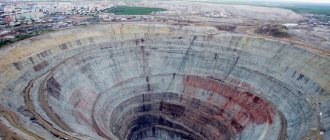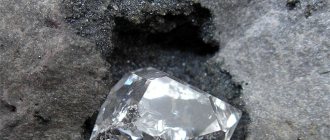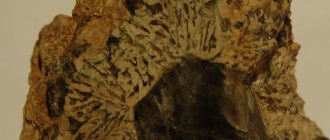Not everyone has ever heard of such a rather rare phrase as “kimberlite pipe”. Even those who say that these words are familiar to them, it is still not a fact that they will be able to answer the question of what it is. However, this is what stands at the origins of the jewelry industry, and what we call diamonds. These minerals are mined from huge “holes” in the ground, just looking at which you stop treating the word “pipe” as something small and almost toy. The history of this phrase originates in Africa, and this method of diamond mining is truly amazing in its scale and how many people keep the mines running. Let's figure out what it is and why entire cities are often built around such deposits. Believe me, the scale will impress you and you will have something to discuss with your friends. And at the same time I’ll tell you what happens to these giants when you can no longer dig them.
The dimensions of kimberlite pipes are enormous.
What are kimberlite pipes?
The small town of Kimberley in the Republic of South Africa is considered the diamond capital of the country. It was here that South Africa's first diamonds were discovered. According to legend, they were found by the children of a shepherd - the first stone weighed just over 21 carats. The diamond was named “Eureka!” - because it was a discovery that turned the entire economy of the country upside down.
A carat is a non-systemic unit of mass equal to 200 mg (0.2 grams). Used in jewelry to express the mass of precious stones and pearls.
The second large diamond was also found by children - the children of a farmer. This was a real miracle: a large yellow diamond weighing more than 83 carats was called the “Star of South Africa”. Both diamonds are now in the museum.
Since then, a real pilgrimage began for diamond seekers and gold miners to Kimberley, who dug all the valleys of the Vaal and Orange rivers in search of treasures. And they found them! Following adventurers of all stripes, geologists came to Kimberley. They noticed the giant Big Hole diamond mine, which became the object of their study.
"Big Hole" with the city of Kimberley in the background
It was then that scientists managed to figure out the relationship between kimberlite pipes and diamonds. By the way, this was not the only “diamond pipe” in the vicinity of Kimberley. But only the “Big Hole” was dug by hand. All the rest have already been developed using machines.
Story
The first pits appeared directly on agricultural plots , which immediately became objects of brisk purchase and sale. The land in the Kimberley region began to resemble a lunar landscape. Miners abandoned unpromising areas, trying to hit the jackpot in richer places. It was not difficult to start developing the deposit: precious stones were found in many mines.
But the most generous mine for diamonds was the mine with the unassuming name Big Hole. Over forty years, thousands of miners removed more than 20 million tons of earth from it. By the time of the flooding, in 1914, it was a huge hole, 460 m wide in diameter. Its depth reached 240 meters. This is the largest hand-dug kimberlite quarry.
All of South Africa turned out to be rich in deposits of precious stones. The Big Hole mine is just one of many . Millions of years ago, numerous volcanic eruptions took place here, which ended in powerful explosions of deep gases. As a result of each such explosion, a narrow tube was formed. This geological formation received its name - kimberlite pipe - from the city of Kimberley.
Kimberlite pipe as a geological formation
A kimberlite pipe can be compared to a giant chimney or well. Externally, “diamond tubes” resemble a funnel: they are wider towards the surface of the earth and narrow, going deeper. In fact, it is a kind of ancient volcano, the ground part of which is completely destroyed due to erosion processes. Therefore, detecting the handset is not easy.
Despite the fact that scientists have been studying kimberlite pipes for many decades, the number of mysteries does not decrease every year. On the contrary: the more we know about them, the more “diamond tubes” surprise scientists.
Here are just two riddles. First, why are kimberlite pipes located on the most ancient and stable platforms? It is known that the earth's crust is not homogeneous. The ocean floor, volcanic plateaus - in these places the earth's thickness is much less, but “diamond pipes” are found on the most stable earth blocks. This does not at all correspond to ordinary logic and the popular wisdom known to us - “where it is thin, it breaks.” The second mystery is the shape of the kimberlite pipe, reminiscent of a martini glass - a cone on a thin stem.
Diamond in the Rough
The contents of the “diamond pipe” - kimberlite - is a rock consisting of olivine, phlogopite, pyrope and other minerals, including natural diamonds. But diamonds are distributed unevenly in a kimberlite pipe. They can be compared to the arrangement of raisins in a bun: somewhere more, somewhere less, somewhere not at all.
The uneven distribution of diamonds in kimberlite diatremes significantly complicates the planned development of primary deposits. Identifying the features of vertical variability of kimberlite rocks to the depth of their profitable mining is one of the most important tasks. Despite the study of the diatremes of the Siberian Platform, the issues of their diamond potential are debatable.
Journal "Domestic Geology" 2022, article by N.N. Zinchuk “Features of diamond potential of different phases of kimberlite intrusion”
Where do diamonds come from?
Scientists learned that these vents contain a huge amount of diamonds only in the middle of the last century, when a huge diamond deposit, nicknamed the kimberlite pipe, was found on the territory of the African continent (it was later discovered that such natural formations contain about 90% of natural diamond reserves planets).
People could not ignore such an event - and active searches for such deposits began all over the world. Some countries, such as Botswana, Russia, Canada, South Africa, Angola, were lucky, and having discovered the desired rock, they almost immediately began to develop promising finds, digging a deep hole and creating a huge crater.
Subsequently, scientists noticed an interesting feature of such holes: it is extremely dangerous for helicopters and other aircraft to fly over man-made craters, since the huge hole literally sucks them into itself.
Miracle of the World Ocean in Belize748051
How are diamonds born?
What is a diamond? These are crystals of pure carbon, the hardest material born in the depths of the Earth. These are the most transparent, hardest and most expensive stones in the world. Scientists divide diamonds into two groups based on their origin.
Meteorite Diamonds
Such stones are often found at meteorite crash sites. According to the theory, at enormous temperature and pressure upon collision with the Earth, the carbon of the meteorite turns into diamonds and scatters over a vast area. But this is just a theory. Typically, meteorite diamonds are very small and mining them industrially is unprofitable.
Earth Diamonds
They are much more common. The minerals are believed to have originated in the Earth's mantle billions of years ago under great pressure as their crystal lattice formed. The finished stones were brought to the surface during internal explosions in the depths of the Earth. Most of it remained in kimberlite pipes, which brought them to the surface.
Let's take a closer look at how diamonds are born. If we describe the process using kitchen terminology, then to prepare a diamond we need only one ingredient - pure carbon. Then technology decides everything: pressure up to 50 kilobars and temperatures up to 1300 degrees.
The mineral is formed very deep in the bowels of the Earth - up to two hundred kilometers. And kimberlite pipes are transport arteries that eject diamonds to the surface.
Project of the future
Today, employees of the Alice architectural bureau have developed a grandiose plan for using the exhausted quarry. The authors of this concept propose to create a “City under a Dome” in an empty huge pit. It is assumed that the pit will be bursting with a concrete structure, and a transparent dome with solar panels capable of generating up to 200 MW of electricity will be installed on top.
©
The internal space is planned to be divided into three levels:
- lower tier for growing agricultural products;
- medium - for creating forest parks designed to purify the air;
- the upper part will be occupied by a residential area for 10 thousand people.
A constant comfortable temperature will be maintained on the territory of the autonomous eco-city. In addition, you can use the heat of the earth itself. In winter in Mirny the air cools to -60°C, but at a depth below 150 m the ground temperature is above zero, which adds greater energy efficiency to the project.
Kimberlite pipe "Mir"
In Yakutia, near the city of Mirny, there is the largest diamond quarry in the world - the Mir kimberlite pipe. This diamond pipe was discovered by Soviet geologists in 1955. And a year earlier - in 1954 - the first “diamond tube” in Yakutia was found, which was called “Zarnitsa”. Despite the fact that it was discovered earlier, it was Mir that began to be developed first.
The history of the discovery of the Mir kimberlite pipe is unusual in its own way. Soviet geologist Natalya Vladimirovna Kind compiled a forecast map and indicated the approximate area where the “diamond pipe” should be located. An expedition headed by three experienced geologists: Yuri Ivanovich Khabardin, Ekaterina Nikolaevna Elagina and Vladimir Petrovich Avdeenko set off in search of her. When geologists were convinced that the forecast map correctly pointed to the kimberlite pipe, determined its boundaries and took samples of kimberlite, they sent an encrypted telegram to management.
We smoked a peace pipe, the tobacco was excellent. Avdeenko, Elagina, Khabardin.
radiogram about the discovery of the Mir diamond pipe on June 13, 1955
Just two years after the discovery of the Mir kimberlite pipe, open-pit diamond mining began. Only 44 years later, when the surface possibilities were completely exhausted, in 2001, diamond miners switched to the underground method. Over these four decades, the Mir quarry has become the largest in the world: its depth is 525 meters, its diameter is 1.2 kilometers. But due to an accident on August 4, 2017, when a water breakthrough occurred at the mine, the quarry was flooded and it is unknown when work will continue.
But it is known for sure that over the years of development of the quarry, diamonds worth 17 billion US dollars were mined. The largest diamond from the Mir kimberlite pipe was found on December 23, 1980. Its weight is 342.5 carats. Diamond was given the Soviet name “XXVI Congress of the CPSU”.
Varieties of kimberlite
Depending on the composition, the rock is divided into kimberlite proper of the 1st group, orangeite or kimberlite of the 2nd class and lamproite. The latter is characterized by olivine in combination with leucite, diopside, orthoclase, richterite and diamond.
Orangeites compose olivine with phlogopite, diopside, monticellite, melilite, picroilmenite, and magmatic calcium. They are complemented by pyrope, sanidine, richterite, and diamond. In kimberlite of the first group, olivine is complemented by phlogopite, diopside, igneous calcite, monticellite, chromite, picroilmenite, diamond, and pyrope.
Pyrope belongs to the garnet family and is a classic companion of diamonds. Diamonds in kimberlite have clear edges, like jewelry. One of the mysteries of kimberlite pipes is connected with this.
The main hypothesis of their origin is that the diamonds were washed up from the depths along with the lava solution. He made his way to the surface, crushing already formed stones. Diamond is the hardest, but also the most fragile on Earth. Why didn't the edges chip?
There is an answer to the seemingly rhetorical question. Another hypothesis provides it. According to it, the path through the already formed rocks was made not by a lava flow, but by a fluid. Often, gases accumulating in the depths seep through the earth's crust.
However, under ancient platforms, where kimberlites are found, it can be difficult for fluid to find a way out. The gases accumulate until they gain the strength to make a needle-shaped hole in the thick earth's crust. This is the stem of the “glass”. In loose surface rocks, it is easier for the fluid to “work” in breadth.
If we take as a basis the hypothesis about the formation of kimberlite in the process of crushing rocks by fluid, it is logical to assume that diamonds were formed in the pipes themselves from carbon carried along with deep gases.
Diamonds are a product of their combustion when rising to the surface. The conditions were simulated in the laboratory, where in the 70s, under minimal pressure, diamonds were obtained from gas rather than graphite. Until 1968, the latter mineral was considered the only raw material for the synthesis of diamonds.
In addition to dividing kimberlites by composition, there is a classification according to the occurrence horizon:
- The upper rock is loose and extends up to 8 meters deep. For every meter of kimberlite in the surface horizon, there are 10-15 cracks.
- From 8 to 140 meters horizon there is kimberlite of medium density. This rock is not affected by weathering, and the cracks in it are filled with calcite. There are no more than 5 such formations per meter.
- Below 140 meters there is a third horizon. The kimberlite in it is the densest, devoid of calcite inserts.
Kimberlite rock
It turns out that its physical properties depend on the depth of the rock. Therefore, kimberlite does not have classical density and the hardness that depends on it. There are samples stronger than quartz, and there are also those that are inferior to apatite. The kimberlite in the photo also looks different depending on what horizon it was lifted from.
Rating of the largest diamonds in the world
Gemstone specialists - gemologists - have compiled a rating of the world's largest diamonds, dividing them into processed and untreated. Let's talk about the three largest diamonds from both ratings.
Cut diamonds
In third place is the Star of Sierra Leone diamond weighing 969.8 carats. The diamond was found in the Dominican Republic in 1972 and was immediately sold for $2.5 million. The stone was cut into 17 diamonds, of which 13 crystals were of impeccable quality and clarity. The largest of them is named, like the diamond from which it is made, “The Star of Sierra Leone.” It weighs 53.96 carats and is set in the Star of Sierra Leone brooch along with five diamonds from the same stone.
In second place is the Excelsior diamond, weighing 971.9 carats, which has a brilliant blue hue. In its raw form, the size of the stone reached 8 cm in height. For the most profitable sale, the Excelsior was divided into several small diamonds.
In first place is the Cullinan diamond, weighing 1,036.3 carats. The weight of the stone in its rough form was even greater - 3136 carats. The stone was handed over to the English monarchy and divided into two parts. One diamond, the “Star of Africa,” now adorns the royal scepter, the second, the “Little Star of Africa,” is kept in the royal treasury.
Diamonds in the rough
In third place is the Legend of Lesotho diamond weighing 910 carats. It was found relatively recently, in 2022, and is estimated at $40 million.
In second place is a Botswana diamond weighing 1,111 carats, found in 2015. He has not yet received his own name. The diamond's value is estimated at $110 million.
In first place is the Sergio diamond, weighing 3,167 carats. It was found in 1895 and experts are convinced that this diamond is of meteorite origin. It was decided to leave it untreated due to many small cracks.
We can talk about diamonds endlessly. Many of them have their own story: adventure, detective, romantic, and sometimes bloody. Better yet, admire diamonds that were born billions of years ago.
More information about the composition of kimberlite
Like all ultramafic rocks, 15–43% of kimberlite's mass is magnesium oxide. Carbon dioxide in the rock is 10-15%. At least 5% must contain aluminum compounds with oxygen. One percent of the rock mass is phosphorus. The latter is due to the apatite content in kimberlite. This is a calcium-containing phosphate.
In addition to apatite, kimberlite stone is composed of:
- olivine is an iron-containing silicate, which accounts for a maximum of 5% of the rock mass
- garnet, which in addition to the silica group contains iron, magnesium, calcium and manganese
- chromite, which is an oxide of manganese and chromium
- picroilmenite, in which iron oxide is combined with titanium
- calcite - calcium carbonate, otherwise called lime spar
- phlogopite is a layered silicate, popularly called mica
- serpentine, which is a magnesium-iron silicate with a layered structure
- pervoskite consisting of calcium, titanium and oxygen
- ilmenite composed of titanium, oxygen and iron
- diamond, the crystal lattice of which consists of carbon atoms
- leucite - a combination of potassium and aluminum and silicon oxides
- diopside, which combines oxides of silicon, magnesium and calcium
- melilite - silicon dioxide combined with oxides of iron, magnesium, calcium, sodium
The mineral composition of kimberlite varies depending on the location. However, olivine is always present. Often 3-4 stones come with it. The complete mineral composition of kimberlite is rare.
Kimberlite rock makes up the so-called pipes. In fact, these are bacilli-shaped formations that go deep into the earth’s crust. The base of the “glass” can lie at a level of more than 1.5 meters.











